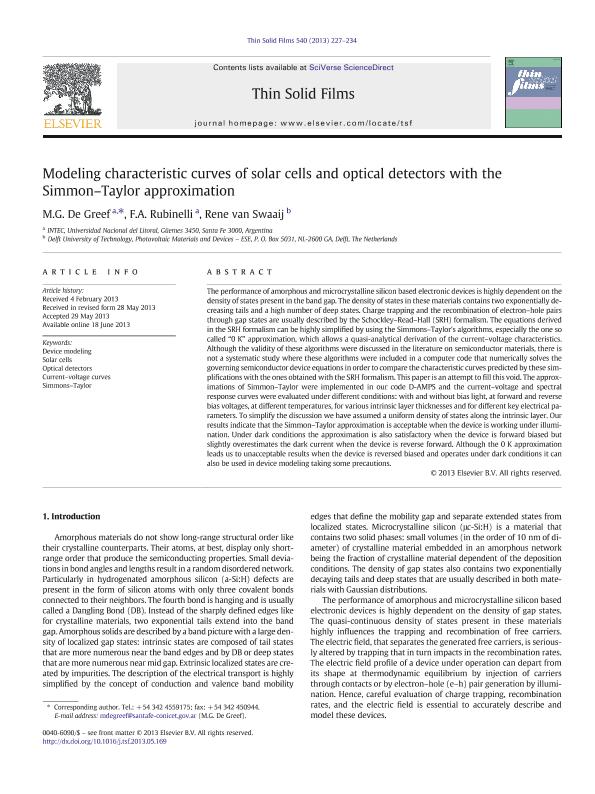Artículo
Modeling characteristic curves of solar cells and optical detectors with the Simmon-Taylor approximation
Fecha de publicación:
08/2013
Editorial:
Elsevier Science SA
Revista:
Thin Solid Films
ISSN:
0040-6090
Idioma:
Inglés
Tipo de recurso:
Artículo publicado
Clasificación temática:
Resumen
The performance of amorphous and microcrystalline silicon based electronic devices is highly dependent on the density of states present in the band gap. The density of states in these materials contains two exponentially decreasing tails and a high number of deep states. Charge trapping and recombination of electron-hole pairs through gap states are usually described by the Schockley-Read-Hall (SRH) formalism. The equations derived in the SRH formalism can be highly simplified by using the Simmons-Taylor's algorithms, especially the one so called 0K approximation, which allows a quasi-analytical derivation of the current-voltage characteristics. Although the validity of these algorithms were discussed in the literature on semiconductor materials, there is no a systematic study where these algorithms were included in a computer code that numerically solves the governing semiconductor device equations in order to compare the characteristic curves predicted by these simplifications with the ones obtained with the SRH formalism. This paper is an attempt to fill this void. The approximations of Simmon-Taylor were implemented in our code D-AMPS and the current-voltage and spectral responses curves were evaluated under different conditions: with and without bias light, at forward and reverse bias voltages, at different temperatures, for various intrinsic layer thicknesses and for different key electrical parameters. To simplify the discussion we have assumed an uniform density of states along the intrinsic layer. Our results indicate that the Simmon-Taylor approximation is acceptable when the device is working under illumination. Under dark conditions the approximation is also satisfactory when the device is forward biased but slightly overestimates the dark current when the device is reverse forward. Although the 0K approximation leads us to unacceptable results when the device is reversed biased and operates under dark conditions it can also be used in device modeling taking some precautions.
Archivos asociados
Licencia
Identificadores
Colecciones
Articulos(INTEC)
Articulos de INST.DE DES.TECNOL.PARA LA IND.QUIMICA (I)
Articulos de INST.DE DES.TECNOL.PARA LA IND.QUIMICA (I)
Citación
de Greef, Marcelo Gastón; Rubinelli, Francisco Alberto; Van Swaaij, Rene; Modeling characteristic curves of solar cells and optical detectors with the Simmon-Taylor approximation; Elsevier Science SA; Thin Solid Films; 540; 8-2013; 227-234
Compartir
Altmétricas




